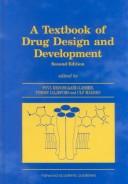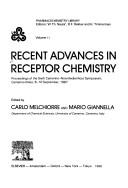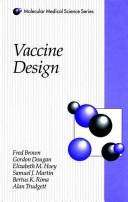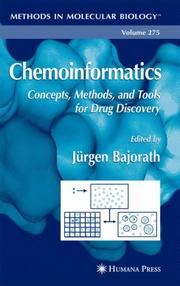| Listing 1 - 10 of 58 | << page >> |
Sort by
|

ISBN: 3718658674 9783718658664 3718658666 9783718658671 Year: 1996 Publisher: Australia: Harwood,
Abstract | Keywords | Export | Availability | Bookmark
 Loading...
Loading...Choose an application
- Reference Manager
- EndNote
- RefWorks (Direct export to RefWorks)
Drug Design --- Drugs --- Design --- Drug Design. --- Drug Modeling --- Design, Drug --- Designs, Drug --- Drug Designs --- Drug Modelings --- Modeling, Drug --- Modelings, Drug --- Drug design --- Pharmaceutical design --- Drug development --- Design. --- Computer-Aided Drug Design --- Computerized Drug Design --- Pharmaceutical Design --- Computer Aided Drug Design --- Computer-Aided Drug Designs --- Computerized Drug Designs --- Design, Computer-Aided Drug --- Design, Computerized Drug --- Design, Pharmaceutical --- Designs, Computer-Aided Drug --- Designs, Computerized Drug --- Designs, Pharmaceutical --- Drug Design, Computer-Aided --- Drug Design, Computerized --- Drug Designs, Computer-Aided --- Drug Designs, Computerized --- Pharmaceutical Designs --- Drugs - Design

ISBN: 0444415645 0444873805 9780444873804 9780444996787 9780444415646 0444996788 Year: 1983 Publisher: Amsterdam Oxford New York Elsevier Scientific
Abstract | Keywords | Export | Availability | Bookmark
 Loading...
Loading...Choose an application
- Reference Manager
- EndNote
- RefWorks (Direct export to RefWorks)
#Lilly --- Pharmaceutical chemistry --- Chemistry, Pharmaceutical --- Dosage Forms --- Drug Design --- Drug Therapy --- Pharmacology --- Computer-Aided Drug Design --- Computerized Drug Design --- Drug Modeling --- Pharmaceutical Design --- Computer Aided Drug Design --- Computer-Aided Drug Designs --- Computerized Drug Designs --- Design, Pharmaceutical --- Drug Design, Computer-Aided --- Drug Design, Computerized --- Drug Designs --- Drug Modelings --- Pharmaceutical Designs --- Dosage Form --- Form, Dosage --- Forms, Dosage --- Drug Administration Routes --- Drug Delivery Systems --- Chemistry, Pharmaceutic --- Pharmaceutic Chemistry --- Pharmaceutical Chemistry --- Medicinal Chemistry --- Chemistry, Medicinal --- Congresses --- trends --- Antibiotiques --- Chimie pharmaceutique
Book
ISBN: 8716108108 9788716108104 Year: 1992 Volume: vol 33 Publisher: Copenhagen Munksgaard
Abstract | Keywords | Export | Availability | Bookmark
 Loading...
Loading...Choose an application
- Reference Manager
- EndNote
- RefWorks (Direct export to RefWorks)
Drug Design --- Pharmacokinetics --- Pharmacology --- Pharmacologies --- Pharmaceutical Preparations --- Drug Kinetics --- Kinetics, Drug --- Drug Modeling --- Design, Drug --- Designs, Drug --- Drug Designs --- Drug Modelings --- Modeling, Drug --- Modelings, Drug --- pharmacology --- pharmacokinetics --- Conferences - Meetings --- Pharmacology. --- Pharmaceutical research --- Congresses --- Computer-Aided Drug Design --- Computerized Drug Design --- Pharmaceutical Design --- Computer Aided Drug Design --- Computer-Aided Drug Designs --- Computerized Drug Designs --- Design, Computer-Aided Drug --- Design, Computerized Drug --- Design, Pharmaceutical --- Designs, Computer-Aided Drug --- Designs, Computerized Drug --- Designs, Pharmaceutical --- Drug Design, Computer-Aided --- Drug Design, Computerized --- Drug Designs, Computer-Aided --- Drug Designs, Computerized --- Pharmaceutical Designs --- ADME --- ADME-Tox --- ADMET --- Absorption, Distribution, Metabolism, Elimination, and Toxicology --- Absorption, Distribution, Metabolism, and Elimination --- LADMER --- Liberation, Absorption, Distribution, Metabolism, Elimination, and Response
Book
ISBN: 9780702042904 9780702042911 Year: 2013 Publisher: Edinburgh Churchill Livingstone
Abstract | Keywords | Export | Availability | Bookmark
 Loading...
Loading...Choose an application
- Reference Manager
- EndNote
- RefWorks (Direct export to RefWorks)
Dosage Forms. --- Biopharmaceutics --- Drug Compounding --- Drug Design. --- methods. --- Drug Modeling --- Design, Drug --- Designs, Drug --- Drug Designs --- Drug Modelings --- Modeling, Drug --- Modelings, Drug --- Dosage Form --- Form, Dosage --- Forms, Dosage --- Drug Administration Routes --- Drug Delivery Systems --- Dosage Forms --- Drug Design --- methods --- Computer-Aided Drug Design --- Computerized Drug Design --- Pharmaceutical Design --- Computer Aided Drug Design --- Computer-Aided Drug Designs --- Computerized Drug Designs --- Design, Computer-Aided Drug --- Design, Computerized Drug --- Design, Pharmaceutical --- Designs, Computer-Aided Drug --- Designs, Computerized Drug --- Designs, Pharmaceutical --- Drug Design, Computer-Aided --- Drug Design, Computerized --- Drug Designs, Computer-Aided --- Drug Designs, Computerized --- Pharmaceutical Designs
Book
ISBN: 0387522328 3540522328 3642754600 3642754589 Year: 1990 Volume: 96 Publisher: Berlin Springer
Abstract | Keywords | Export | Availability | Bookmark
 Loading...
Loading...Choose an application
- Reference Manager
- EndNote
- RefWorks (Direct export to RefWorks)
Antifungal agents --- Mycoses --- Antifongiques --- Therapeutic use --- Drug therapy --- Chemotheapy --- Antifungal Agents --- Drug Design. --- Drug Modeling --- Design, Drug --- Designs, Drug --- Drug Designs --- Drug Modelings --- Modeling, Drug --- Modelings, Drug --- therapeutic use. --- drug therapy. --- ANTIFUNGAL AGENTS, therapeutic use --- MYCOSES --- Drug design --- drug therapy --- ANTIFUNGAL AGENTS, therapeutic use. --- Drug design. --- Antifungal agents, therapeutic use. --- Drug therapy. --- Computer-Aided Drug Design --- Computerized Drug Design --- Pharmaceutical Design --- Computer Aided Drug Design --- Computer-Aided Drug Designs --- Computerized Drug Designs --- Design, Computer-Aided Drug --- Design, Computerized Drug --- Design, Pharmaceutical --- Designs, Computer-Aided Drug --- Designs, Computerized Drug --- Designs, Pharmaceutical --- Drug Design, Computer-Aided --- Drug Design, Computerized --- Drug Designs, Computer-Aided --- Drug Designs, Computerized --- Pharmaceutical Designs --- Drug Design --- therapeutic use

ISBN: 0471937274 Year: 1993 Publisher: Chichester : J. Wiley,
Abstract | Keywords | Export | Availability | Bookmark
 Loading...
Loading...Choose an application
- Reference Manager
- EndNote
- RefWorks (Direct export to RefWorks)
Synthetic vaccines --- Vaccines --- Drug Design --- Design --- Drug Design. --- Vaccines. --- -Biologicals --- Synthetic antigens --- Drug Modeling --- Design, Drug --- Designs, Drug --- Drug Designs --- Drug Modelings --- Modeling, Drug --- Modelings, Drug --- Synthetic vaccines. --- Design. --- -Design --- Biologicals --- Computer-Aided Drug Design --- Computerized Drug Design --- Pharmaceutical Design --- Computer Aided Drug Design --- Computer-Aided Drug Designs --- Computerized Drug Designs --- Design, Computer-Aided Drug --- Design, Computerized Drug --- Design, Pharmaceutical --- Designs, Computer-Aided Drug --- Designs, Computerized Drug --- Designs, Pharmaceutical --- Drug Design, Computer-Aided --- Drug Design, Computerized --- Drug Designs, Computer-Aided --- Drug Designs, Computerized --- Pharmaceutical Designs --- Vaccine
Book
ISBN: 9781405185745 1405185740 9781118345313 1118345347 1280698179 9786613675132 1118345320 1118345312 1118345339 Year: 2012 Publisher: Chichester, West Sussex : Wiley-Blackwell,
Abstract | Keywords | Export | Availability | Bookmark
 Loading...
Loading...Choose an application
- Reference Manager
- EndNote
- RefWorks (Direct export to RefWorks)
"This book addresses a profound deficiency in the field of vaccine research and development, namely the lack of a single volume describing the design and construction of vaccine strategies from first principles to implementation. This is an authoritative textbook that details a comprehensive and systematic approach to the science of vaccinology focusing on not only basic science, but the many stages required to commercialize and navigate the regulatory requirements for human application both in the United States and Europe. The book has broad appeal to clinicians, scientific and medical researchers alike, and graduate students"--Provided by publisher.
Vaccines. --- Drug Design. --- Vaccination --- Drug development. --- Vaccination. --- Vaccins --- Médicaments --- methods. --- Développement --- Médicaments --- Développement --- Vaccines --- Drug Design --- Computer-Aided Drug Design --- Computerized Drug Design --- Drug Modeling --- Pharmaceutical Design --- Computer Aided Drug Design --- Computer-Aided Drug Designs --- Computerized Drug Designs --- Design, Computer-Aided Drug --- Design, Computerized Drug --- Design, Drug --- Design, Pharmaceutical --- Designs, Computer-Aided Drug --- Designs, Computerized Drug --- Designs, Drug --- Designs, Pharmaceutical --- Drug Design, Computer-Aided --- Drug Design, Computerized --- Drug Designs --- Drug Designs, Computer-Aided --- Drug Designs, Computerized --- Drug Modelings --- Modeling, Drug --- Modelings, Drug --- Pharmaceutical Designs --- Vaccine --- methods
Book
ISBN: 0128163720 0128157992 9780128163726 9780128157992 Year: 2019 Publisher: Waltham, MA : Elsevier,
Abstract | Keywords | Export | Availability | Bookmark
 Loading...
Loading...Choose an application
- Reference Manager
- EndNote
- RefWorks (Direct export to RefWorks)
Pharmaceutical Quality by Design: Principles and Applications discusses the Quality by Design (QbD) concept implemented by regulatory agencies to ensure the development of a consistent and high-quality pharmaceutical product that safely provides the maximum therapeutic benefit to patients. The book walks readers through the QbD framework by covering the fundamental principles of QbD, the current regulatory requirements, and the applications of QbD at various stages of pharmaceutical product development, including drug substance and excipient development, analytical development, formulation development, dissolution testing, manufacturing, stability studies, bioequivalence testing, risk and assessment, and clinical trials. Contributions from global leaders in QbD provide specific insight in its application in a diversity of pharmaceutical products, including nanopharmaceuticals, biopharmaceuticals, and vaccines. The inclusion of illustrations, practical examples, and case studies makes this book a useful reference guide to pharmaceutical scientists and researchers who are engaged in the formulation of various delivery systems and the analysis of pharmaceutical product development and drug manufacturing process.
Drugs --- Quality control. --- Drug Design. --- Quality Control. --- Medicaments --- Medications --- Medicine (Drugs) --- Medicines (Drugs) --- Pharmaceuticals --- Prescription drugs --- Bioactive compounds --- Medical supplies --- Pharmacopoeias --- Chemotherapy --- Materia medica --- Pharmacology --- Pharmacy --- Control, Quality --- Controls, Quality --- Quality Controls --- Scientific Experimental Error --- Total Quality Management --- Computer-Aided Drug Design --- Computerized Drug Design --- Drug Modeling --- Pharmaceutical Design --- Computer Aided Drug Design --- Computer-Aided Drug Designs --- Computerized Drug Designs --- Design, Computer-Aided Drug --- Design, Computerized Drug --- Design, Drug --- Design, Pharmaceutical --- Designs, Computer-Aided Drug --- Designs, Computerized Drug --- Designs, Drug --- Designs, Pharmaceutical --- Drug Design, Computer-Aided --- Drug Design, Computerized --- Drug Designs --- Drug Designs, Computer-Aided --- Drug Designs, Computerized --- Drug Modelings --- Modeling, Drug --- Modelings, Drug --- Pharmaceutical Designs --- Drug development --- Design

ISBN: 128036002X 9786610360024 1592598021 1588292614 9781588292612 1617374598 Year: 2004 Publisher: Totowa, NJ : Humana Press : Imprint: Humana,
Abstract | Keywords | Export | Availability | Bookmark
 Loading...
Loading...Choose an application
- Reference Manager
- EndNote
- RefWorks (Direct export to RefWorks)
In the post-genomic era, the role informatics technologies plays in chemical and pharmaceutical research has become increasingly important in data management and lead-compound identification. In Chemoinformatics: Concepts, Methods, and Tools for Drug Discovery, well-recognized pioneers and investigators from diverse professional environments survey the key concepts in the field, describe cutting-edge methods, and provide exemplary pharmaceutical applications. The authors explain the theory behind the crucial concepts of molecular similarity and diversity, describe the challenging efforts to use chemoinformatics approaches to virtual and high-throughput screening, and illuminate the latest developments in multidimensional QSAR analysis. Other topics of interest include the use of partitioning algorithms and classification methods for analyzing large compound databases, screening sets, and virtual screening for active molecules; different approaches to target class-specific library design; the generation of novel classes of molecular descriptors; and Web-based tools for chemical database access and management. Also presented are different methods for describing molecular chirality and conformational parameters and for predicting the drug-like character and basic ADME properties of compounds based on modeling their putative interactions with cytochrome P450 isoforms. State-of-the-art and user-friendly, Chemoinformatics: Concepts, Methods, and Tools for Drug Discovery illuminates the conceptual and methodological diversity of this rapidly evolving field and offers instructive examples of cutting-edge applications in the drug discovery process.
Pharmacy. --- Chemistry --- Medicine --- Drugs --- Materia medica --- Pharmacology --- Cheminformatics --- Drug Design --- Chemistry, Pharmaceutical --- Combinatorial Chemistry Techniques --- Computer-Aided Design --- Computer-Aided Drug Design --- Computerized Drug Design --- Drug Modeling --- Pharmaceutical Design --- Computer Aided Drug Design --- Computer-Aided Drug Designs --- Computerized Drug Designs --- Design, Computer-Aided Drug --- Design, Computerized Drug --- Design, Drug --- Design, Pharmaceutical --- Designs, Computer-Aided Drug --- Designs, Computerized Drug --- Designs, Drug --- Designs, Pharmaceutical --- Drug Design, Computer-Aided --- Drug Design, Computerized --- Drug Designs --- Drug Designs, Computer-Aided --- Drug Designs, Computerized --- Drug Modelings --- Modeling, Drug --- Modelings, Drug --- Pharmaceutical Designs --- Chemical informatics --- Chemiinformatics --- Chemoinformatics --- Chemistry informatics --- Information science --- Computational chemistry --- methods --- trends --- Data processing
Book
ISBN: 9814998702 9814998699 9789814998697 Year: 2021 Publisher: Singapore : Bentham Science Publishers Pte. Ltd.,
Abstract | Keywords | Export | Availability | Bookmark
 Loading...
Loading...Choose an application
- Reference Manager
- EndNote
- RefWorks (Direct export to RefWorks)
Bioinformatics allows researchers to answer biological questions with advanced computational methods which involves the application of statistics and mathematical modeling. Structural bioinformatics enables the prediction and analysis of 3D structures of macromolecules while Computer Aided Drug Designing (CADD) assists scientists to design effective active molecules against diseases. However the concepts in structural bioinformatics and CADD can be complex to understand for students and educated laymen. This quick guideline is intended as a basic manual for beginner students and instructors involved in bioinformatics and computational chemistry courses. Readers will learn the basics of structural bioinformatics primary and secondary analysis and prediction structural visualization structural analysis and molecular docking. The book provides the reader an easy to read summary of the tools and techniques in structural bioinformatics as well as their limitations. In this revised edition the authors have updated information in a number of chapters with a specific focus on the section on protein structure visualization and evaluation. Additional information on protein-ligand interaction studies has also been provided in this new edition. Therefore the book is a useful handbook for aspiring scholars who wish to learn the basic concepts in computational analysis of biomolecules.
Drug Design. --- Computer-Aided Design. --- CAD-CAM --- Computer-Aided Manufacturing --- Computer-Assisted Design --- Computer-Assisted Manufacturing --- Computer Aided Design --- Computer Aided Manufacturing --- Computer Assisted Design --- Computer Assisted Manufacturing --- Computer-Aided Designs --- Computer-Assisted Designs --- Design, Computer-Aided --- Design, Computer-Assisted --- Designs, Computer-Aided --- Designs, Computer-Assisted --- Manufacturing, Computer-Aided --- Manufacturing, Computer-Assisted --- Drug Design --- Computer-Aided Drug Design --- Computerized Drug Design --- Drug Modeling --- Pharmaceutical Design --- Computer Aided Drug Design --- Computer-Aided Drug Designs --- Computerized Drug Designs --- Design, Pharmaceutical --- Drug Design, Computer-Aided --- Drug Design, Computerized --- Drug Designs --- Drug Modelings --- Pharmaceutical Designs --- Drugs --- Design.
| Listing 1 - 10 of 58 | << page >> |
Sort by
|

 Search
Search Feedback
Feedback About UniCat
About UniCat  Help
Help News
News